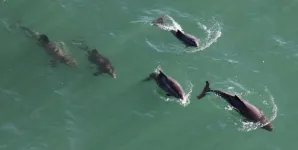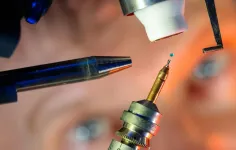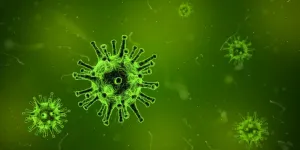(Press-News.org) Harbor porpoises have rebounded in a big way off California. Their populations have recovered dramatically since the end of state set-gillnet fisheries that years ago entangled and killed them in the nearshore waters they frequent. These coastal set-gillnet fisheries are distinct from federally-managed offshore drift-gillnet fisheries. They have been prohibited in inshore state waters for more than a decade. The new research indicates that the coastal set gillnets had taken a greater toll on harbor porpoise than previously realized.
The return of harbor porpoises reflects the first documented example of the species rebounding. It's a bright spot for marine wildlife, the scientists write in a new assessment published in Marine Mammal Science.
"This is very good evidence that if we can eliminate the deaths in fishing nets, marine mammal populations can come back in a big way," said Karin Forney, a research biologist with NOAA Fisheries' Southwest Fisheries Science Center who is based in Monterey Bay.
The State of California managed set-gillnet fisheries for white seabass and halibut in coastal waters off central California beginning in the 1930s. Before the 1980s, there was little solid information about the impacts of coastal set-gillnets on protected species such as marine mammals and seabirds. Harbor porpoises were vulnerable to this coastal fishery because they frequent shallow inshore waters where the nets were historically set.
The scientists estimated, based on a combination of data, that as many as 300 harbor porpoises per year may have been killed in California's coastal set-gillnet fisheries during the 1980s. One 1994 study confirmed the deaths of more than 50 harbor porpoises in Monterey Bay alone, with the authors speculating that the true number was far higher.
Rebound for Populations
In the late 1980s, fishery protections for seabirds and southern sea otters benefited harbor porpoises, too. Three of the four stocks of harbor porpoises off the California Coast rebounded as the coastal set-gillnets were largely phased out, the new study shows. These coastal gillnets have been prohibited north of the Sonoma-Mendocino County line (north of Santa Rosa) since the early 1900s. That safeguarded the fourth stock, the more remote Northern California/Southern Oregon population.
The Morro Bay population most clearly reflected the rebound. Biologists estimated the population numbered about 570 animals in 1991. Surveys in the last few years estimate the population at approximately 4,200 porpoises, a roughly seven-fold increase.
The rapid growth of the Morro Bay stock suggests that bycatch had depressed the population, especially before and during the 1980s. The population decreased more than researchers had recognized previously, the scientists reported in the new study. They concluded that it "is likely that unmonitored fisheries had a dramatic adverse impact on the Morro Bay population before monitoring of harbor porpoise began in 1986."
"We didn't really know how heavily the Morro Bay population had been impacted by the white seabass and halibut gillnets at the time," Forney said. "It is now clear that the toll was more severe than we thought."
She said the finding has significance for other marine mammals still threatened by gillnets. Unlawful gillnets in Mexico have pushed the critically endangered vaquita to the brink of extinction, for example. Repeated surveys have found that the number of surviving animals may now be in the single digits. The vaquita is the world's smallest porpoise that lives in the turbid waters of the Gulf of California, where those gillnets target a large and also endangered native fish that is prized in China as traditional medicine.
"The story in California tells us that these animals are capable of recovering if we eliminate the factors causing their decline, in this case, gillnet bycatch from coastal fisheries within the range of harbor porpoise," Forney said.
Surveys Track Porpoise Numbers
Aerial surveys for harbor porpoises off California began in 1986, collecting data that formed the foundation of the new population assessment. Scientists supplemented the surveys with additional porpoise sightings from surveys of endangered leatherback turtles. The consistency of the surveys that continued over decades make them valuable in detecting changes. California harbor porpoises were once considered a single population. Beginning in 2001 biologists recognized there were four genetically distinct stocks: Morro Bay, Monterey Bay, San Francisco/Russian River, and Northern California/Southern Oregon.
The new analysis shows that three of the four stocks increased in number since the days of coastal set gillnet fishing, and have recently begun to stabilize:
Morro Bay: Increased almost 10 percent a year after most coastal gillnetting ceased by 2001, now numbering about 4,200 porpoises.
Monterey Bay: Population grew faster after coastal gillnetting stopped in 2003, but not as fast as Morro Bay. Most recently estimated at about 3,760 porpoises.
San Francisco/Russian River: Numbers fell until coastal gillnetting was prohibited in 1987. Beginning about 2009, hundreds of harbor porpoises became regularly visible in San Francisco Bay, perhaps benefiting from improved water quality, and earlier changes such as the removal of an anti-submarine netting that blocked the Golden Gate. Now estimated at 7,777 individuals.
Northern California/Southern Oregon: Lesser known population that is California's largest at about 12,160 porpoises.
Drift gillnet separate fishery
A small federal drift-gillnet fishery for swordfish continues in deeper waters miles off California. This fishery operates too far offshore to affect harbor porpoises. The fishery adopted stringent bycatch reduction measures in the 1990s and early 2000s to protect marine mammals and sea turtles. To protect marine mammals, the top of the nets hang below the surface so marine mammals can pass overhead. Acoustic "pingers" warn marine mammals of the nets' presence. To protect leatherback sea turtles, federal fishery managers close a large area off California to drift gillnets each year when the turtles are present. The measures have dramatically reduced bycatch of marine mammals and sea turtles.
"We now know much more about how to protect these species from fishing impacts," Forney said, "and we are seeing the results."
INFORMATION:
A new study shows that humans express a powerful hormone during exercise and that treating mice with the hormone improves physical performance, capacity and fitness. Researchers say the findings present new possibilities for addressing age-related physical decline.
The research, published on Wednesday in Nature Communications, reveals a detailed look at how the mitochondrial genome encodes instructions for regulating physical capacity, performance and metabolism during aging and may be able to increase healthy lifespan.
"Mitochondria are known as the cell's energy source, but they are also hubs that coordinate and fine-tune metabolism by actively communicating to the rest of the body," said Changhan David Lee, assistant professor at the USC Leonard Davis School of Gerontology ...
BOSTON - Opioid addiction is persistently stigmatized, delaying and preventing treatment for many - an urgent problem with overdose deaths continuing to rise. To help alleviate this, various medical ways of describing opioid-related impairment, such as "a chronically relapsing brain disease," "illness," or "disorder," have been promoted in diagnostic systems and among national health agencies.
"While intensely debated, there were no rigorous scientific studies out there to inform practice and policy about which terms may be most helpful in reducing stigma," says John F. Kelly, PhD, lead investigator ...
Two novel techniques, atomic-resolution real-time video and conical carbon nanotube confinement, allow researchers to view never-before-seen details about crystal formation. The observations confirm theoretical predictions about how salt crystals form and could inform general theories about the way in which crystal formation produces different ordered structures from an otherwise disordered chemical mixture.
Crystals include many familiar things, such as snowflakes, salt grains and even diamonds. They are regular and repeating arrangements of constituent molecules that grow from a chaotic sea of those molecules. ...
Researchers from King's College London have shown that whole body magnetic resonance imaging (WBMRI) not only detects more myeloma-defining disease than positron emission tomography/computed tomography (PET/CT) with 18F-fluorodeoxyglucose (FDG) but that it also allows critical treatment to be initiated earlier.
In a study published today in the European Journal of Nuclear Medicine and Molecular Imaging, researchers looked at 46 patients with suspected myeloma, a debilitating bone marrow cancer which sees 140,000 new cases each year globally.
Less than 50 percent of patients survive after five years and at present it is not clear which is the best imaging ...
"Such reactions are usually carried out using transition metals, such as nickel or iridium," explains Prof. Robert Kretschmer, Junior Professor of Inorganic Chemistry at the University of Jena, whose work has been published in the prestigious Journal of the American Chemical Society. "However, transition metals are expensive and harmful to the environment, both when they are mined and when they are used. Therefore, we are trying to find better alternatives." That two metals can do more than one is already known in the case of transition metals. "However, there has been hardly ...
Viral respiratory diseases are easily transmissible and can spread rapidly across the globe, causing significant damage. The ongoing covid-19 pandemic is a testament to this. In the past too, other viruses have caused massive respiratory disease outbreaks: for example, a subtype of the influenza virus, the type A H1N1 virus, was responsible for the Spanish flu and the Swine flu outbreaks. Thus, to prevent such health crises in the future, timely and accurate diagnosis of these viruses is crucial. This is exactly what researchers from Korea have attempted to work toward, in their brand-new study. Read on to understand how!
For several decades now, polymerase chain reaction (PCR)-based assays have been the gold standard for detecting influenza viruses. And while these ...
An international study coordinated by the Research Group for Urban Nature and Biosystems Engineering (NATURIB) from the University of Seville's School of Agricultural Engineering emphasises that having plants at home had a positive influence on the psychological well-being of the dwelling's inhabitants during COVID-19 lockdown. Researchers from the Hellenic Mediterranean University (Greece), the Federal Rural University of Pernambuco (Brazil) and the University of Genoa (Italy) participated in the study along with representatives from the University ...
Did you know that fleas, ants, and click beetles are capable of blazingly fast accelerations, with some up to 10^6 meters per square-second? Their quick movements make fast animals like the cheetah look like slowpokes.
A new study by a team that included Jake Socha, professor in biomedical engineering and mechanics in Virginia Tech's College of Engineering, published in the journal Proceedings of the National Academies of Sciences shows that a snap-through unbending movement of the body is the main reason for the clicking beetle's fast acceleration.
Most animals use muscle to move. For example, when we want to bend our elbow, our biceps ...
Countries where massive natural hazard events occur frequently are not more likely than others to make changes to reduce risks from future disasters. This is shown in an interdisciplinary Uppsala University study now published in Nature Communications.
Natural hazard events, such as storms, floods, and wildfires, entail huge and growing costs all over the world, but they can also be occasions for countries to implement risk-reducing changes. There is no research consensus on whether natural hazard events lead to policy modifications or, instead, contribute to stability and preservation of existing solutions. Knowledge in this area to date has been ...
JUPITER, FL - In a landmark neurobiology study, scientists from Scripps Research have discovered a memory gating system that employs the neurotransmitter dopamine to direct transient forgetting, a temporary lapse of memory which spontaneously returns.
The study adds a new pin to scientists' evolving map of how learning, memory and active forgetting work, says Scripps Research Neuroscience Professor Ron Davis, PhD.
"This is the first time a mechanism has been discovered for transient memory lapse," Davis says. "There's every reason to believe, because of conservation ...






